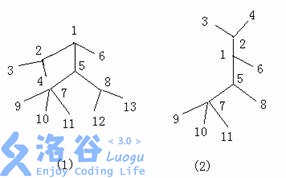[HAOI2009]毛毛虫
题目描述
对于一棵树,我们可以将某条链和与该链相连的边抽出来,看上去就象成一个毛毛虫,点数越多,毛毛虫就越大。例如下图左边的树(图 1 )抽出一部分就变成了右边的一个毛毛虫了(图 2 )。

输入输出格式
输入格式:
在文本文件 worm.in 中第一行两个整数 N , M ,分别表示树中结点个数和树的边数。
接下来 M 行,每行两个整数 a, b 表示点 a 和点 b 有边连接( a, b ≤ N )。你可以假定没有一对相同的 (a, b) 会出现一次以上。
输出格式:
在文本文件 worm.out 中写入一个整数 , 表示最大的毛毛虫的大小。
输入输出样例
输入样例#1: 复制
13 12
1 2
1 5
1 6
3 2
4 2
5 7
5 8
7 9
7 10
7 11
8 12
8 13
输出样例#1: 复制
11
说明
40% 的数据, N ≤ 50000
100% 的数据, N ≤ 300000
题解
我真傻,真的。
我一开始以为以1为根节点。
然后找两条分链加加起来就好了。
测一下60分,以为是对的。
于是。。。。6点到10点,没有调出来,生无可恋。
最后还是看题解了。我真菜
我怎么就没想到要把每一个点作为一次根呢
然后因为是相连的点换根。所以子树的变化就是原根少一个点的子树,那个点的子树加上原根。
dp判断一下当前f[i]表示以i为根的最大长度。
然后毛毛虫可以是拼起来的。也就是说要记录最长和次长链。
end.
代码
#include<cstdio>
#include<cstring>
#include<cmath>
#include<algorithm>
#include<iostream>
using namespace std;
const int N=300005;
struct node{
int nex,to;
}e[N<<1];
int size[N],n,m,num,head[N];
int f[N],ans,pre[N];
void add(int from,int to){
num++;
e[num].to=to;
e[num].nex=head[from];
head[from]=num;
}
int read(){
int x=0,w=1;char ch=getchar();
while(ch>'9'||ch<'0'){if(ch=='-')w=-1;ch=getchar();}
while(ch>='0'&&ch<='9')x=x*10+ch-'0',ch=getchar();
return x*w;
}
void dfs(int x,int fa){
size[x]=1;//int sum=0;
for(int i=head[x];i;i=e[i].nex){
int v=e[i].to;
if(v==fa)continue;
size[x]++;dfs(v,x);
}
}
void dfs2(int x,int fa){
int max1=0,max2=0;
for(int i=head[x];i;i=e[i].nex){
int v=e[i].to;
if(v==fa)continue;
dfs2(v,x);
if(f[v]>max1){
max2=max1;max1=f[v];
}
else if(f[v]>max2)max2=f[v];
f[x]=max(f[x],f[v]+size[x]-1);
}
ans=max(ans,max1+max2-1+size[x]);
}
int main(){
n=read();m=read();
for(int i=1;i<=m;i++){
int x=read(),y=read();
add(x,y);add(y,x);
size[x]++;size[y]++;
}
for(int i=1;i<=n;i++)f[i]=1;
dfs2(1,0);
printf("%d
",ans);
return 0;
}